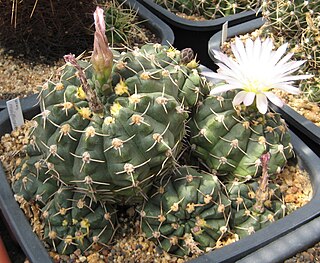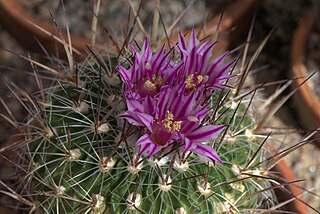
Stetsonia coryne, the toothpick cactus, is the sole species in the cactus genus Stetsonia. Stetsonia coryne is native to arid regions of South America, where it grows to a height of 15 to 25 ft tall. It contains mescaline and other alkaloids.

Rapicactus zaragosae, synonym Turbinicarpus zaragosae, is a species of plant in the family Cactaceae. It is endemic to Mexico. Its natural habitat is hot deserts. It is threatened by habitat destruction.

Gymnocalycium saglionis, the giant chin cactus, is a globular cactus species endemic to northwest Argentina.

Gymnocalycium horstii is a globular cactus resembling a loaf of bread from a bakery.

Selenicereus grandiflorus is a cactus species originating from the Antilles, Mexico and Central America. The species is commonly referred to as queen of the night, night-blooming cereus, large-flowered cactus, sweet-scented cactus or vanilla cactus. The true species is extremely rare in cultivation. Most of the plants under this name belong to other species or hybrids. It is often confused with the genus Epiphyllum.

Thelocactus rinconensis, synonyms including Thelocactus nidulans, is a species of cactus. It is endemic to north-east Mexico.

Gymnocalycium baldianum, the spider-cactus or dwarf chin cactus, is a species of flowering plant in the cactus family Cactaceae, native to the Catamarca Province in Argentina.

Gymnocalycium ragonesei is a species of Gymnocalycium from Argentina.

Gymnocalycium uruguayense is a species of Gymnocalycium from Brazil and Uruguay.

Gymnocalycium amerhauseri is a species of Gymnocalycium from Argentina.
Gymnocalycium taningaense is a species of Gymnocalycium from Argentina.

Gymnocalycium robustum is a species of Gymnocalycium from northern Córdoba and southern Santiago del Estero, Argentina.

Lobivia ferox, is a species of Lobivia found in Bolivia and Argentina.

Stenocactus ochoterenianus is a species of cactus native to the deserts of Mexico.

Gymnocalycium erinaceum is a species of Gymnocalycium from Argentina.

Gymnocalycium castellanosii is a species of Gymnocalycium from Argentina.

Gymnocalycium mostii is a species of Gymnocalycium from Argentina.

Gymnocalycium uebelmannianum is a species of Gymnocalycium from Argentina.

Gymnocalycium nigriareolatum is a species of Gymnocalycium from Argentina.

Gymnocalycium schroederianum is a species of Gymnocalycium from Argentina and Uruguay.



















